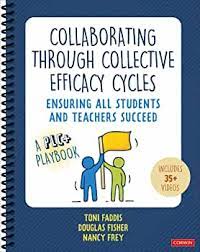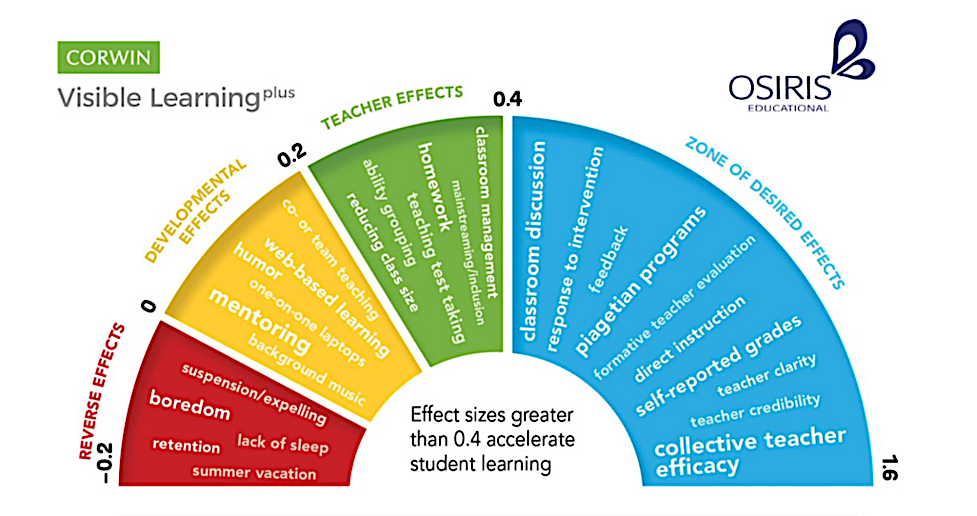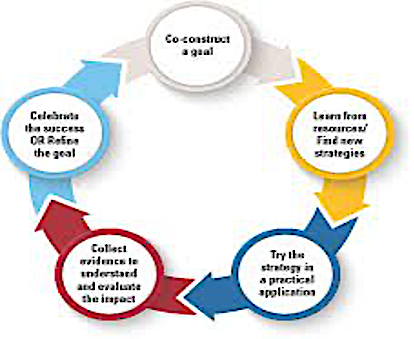Collective Efficacy for Schoolwide Success
Collaborating Through Collective Efficacy Cycles: Ensuring All Students and Teachers Succeed
By Toni Faddis, Douglas Fisher, and Nancy Frey
(Corwin Press, 2022 – Learn more)
Reviewed by Cathy Gassenheimer

Notice the wording above “faculty as a whole” and “perception.” Getting an entire faculty to believe that together they can overcome barriers to learning and help students succeed academically is quite daunting, but also quite important!
If schools need more motivation recall that Hattie’s meta-analyses found collective teacher efficacy to be the top factor in student learning. In fact, if consistently in place, collective teacher efficacy can result in four times the expected annual learning growth for students.
Fostering Collective Efficacy
Clearly, building collective teacher efficacy is challenging. So how does a school get started? That certainly was a question I had as I worked with a group of secondary instructional coaches in one of Alabama’s largest districts. Fortunately, I’d just received an amazing resource in the mail that answered that question.

Written by Toni Faddis, Doug Fisher, and Nancy Frey – all practitioners, scholars and best-selling authors – the playbook has links to more than 35 videos and other just-in-time resources.
I brought the Playbook with me to the first session with the coaches and showed this brief video featuring Doug Fisher explaining the CTE cycle. At the conclusion of the video, one of the coaches asked to see my copy of the book.
Actionable and Timely
The coach flipped through the book, nodding and pointing out sections to her colleagues. It was clear that the playbook was both timely and actionable. It is literally like a coach’s playbook, providing step-by-step moves and insights that can help school teams create and/or strengthen collective teacher efficacy. At the end of the session, the senior staff member told me she planned to order copies of the book for all of her coaches.
How the Book Is Organized
In addition to the introduction and conclusion, the book has six chapters, one for each of the six CTE cycles. An annotated table of contents provides an outline of each chapter. This Amazon link takes you to excerpts from the book, including the table of contents, list of videos, and an overview of the cycle.
Each chapter, or module, begins with an overview of that module. It is followed by what the authors call, “Act 1,” where a brief scenario is described of a team of teachers struggling with a specific challenge or issue. “Act 2,” at the end of each module, picks up on the actions of the teachers, who have worked through that specific CTE cycle.
In addition to the “acts,” the Playbook periodically poses reflection questions and planning documents. In short, it’s a step-by-step guide to help teams cultivate collective teacher efficacy.
Before introducing the Collective Teacher Efficacy Cycle, the authors suggest three “specific, fundamental actions” that generate CTE (p. 9):
- Implementing evidence-based practices with students
- Determining and attaining a shared goal
- Opening up practice through peer observations
Collective Efficacy Cycle: Six Components
The actual collective teacher efficacy cycle has six components that are organized in those modules within the Playbook.
- Developing individual and collective efficacy
- Determining the common challenge
- Building educator knowledge and skills
- Collaborative planning and safe practice
- Collaborative planning and opening up practice
- Monitoring, Modifying, and Celebrating
Reaching Collective Teacher Efficacy
The authors note that collective teacher efficacy “both causes and results from increased student achievement.” To put it another way, consider this formula (p. 147):
High skills x high challenge + success = collective teacher efficacy
No doubt building collective teacher efficacy is hard work. But as the authors point out in the conclusion:
Rather than lamenting challenges, effective teams are positioned to identify student needs, collectively generate solutions, and implement them. Educators and administrators can share ownership of the teaching and learning environment and ensure everyone’s well-being.
In the ideal situation, your team nurtures and sustains collective teacher efficacy such that it becomes the norm – it’s how the school operates. Once collective teacher efficacy becomes the fabric of a system, it’s difficult to imagine going back to a traditional school environment where classroom doors are closed and each teacher is a lone wolf.
Collectively, we can create cultures that cultivate collective teacher efficacy and allow it to thrive. (p. 147)
Cathy Gassenheimer is a professional learning consultant specializing in collaborative adult learning and collective efficacy. For 22 years she was Executive Vice President of the Alabama Best Practices Center, a program of Alabama’s statewide nonprofit A+ Education Partnership, and led the work of three statewide educator networks focused on teaching, leadership, and instructional coaching. Connect with her via LinkedIn and on Twitter @cathygassenheim.






























